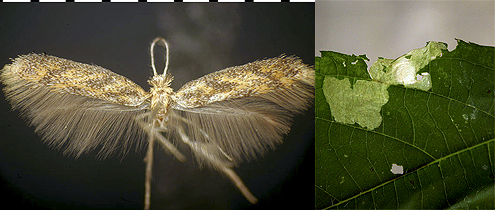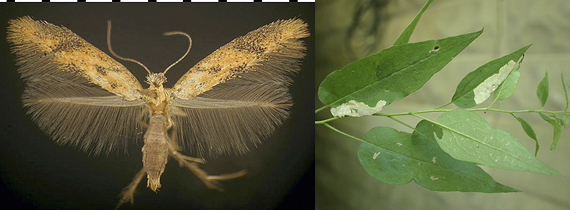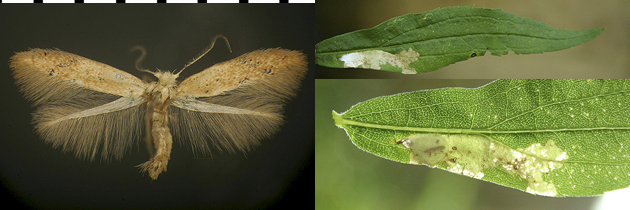
Figure 1. Astrotischeria ambrosiaeella. Adult, and leaf mine on giant ragweed, Ambrosia trifida.
The composite-feeding tischeriids present an array of species that are extremely similar in external appearance. They are separable, however, on genital morphology, and especially on larval biology. All are placed in the genus Astrotischeria.
The larva of Astrotischeria ambrosiaeella (Fig. 1) feeds in a leaf mine on giant ragweed, Ambrosia trifida. In the leaf mine of A. ambrosiaeella, the area of the nidus is green. This makes it easy to distinguish from the mine of A. heliopsisella (which also feeds on A. trifida; see below), in which the area of the nidus is white.

Figure 1. Astrotischeria ambrosiaeella. Adult, and leaf mine on giant ragweed, Ambrosia trifida.
Astrotischeria heliopsisella (Fig. 2) feeds in a leaf mine on smooth oxeye, Heliopsis helianthoides, and also on giant ragweed, Ambrosia trifida. On the latter host, the mine of A. heliopsisella can be distinguished from that of A. ambrosiaeella by the fact that the area of the nidus is white (rather than green, as seen in A. ambrosiaeella).

Astrotischeria astericola (Fig. 3) feeds in a leaf mine on various species of asters, including Symphyotrichum cordifolium (formerly Aster cordifolius) and Symphyotrichum lateriflorum (formerly Aster lateriflorus). The leaf mines tend to be most numerous from late summer into early autumn.

The larva of Astrotischeria solidagonifoliella (Fig. 4) feeds in a leaf mine on goldenrods, Solidago spp. The blackish scaling on the forewing of the illustrated specimen is quite sparse, but in other specimens, it is as extensive as in the illustrated specimens of A. ambrosiaeella and A. astericola.

Figure 4. Astrotischeria solidagonifoliella. Adult, and leaf mine on goldenrod, Solidago sp. Upper panel, normal lighting, with the nidus appearing as the white disc at the left-hand end of the mine; lower panel, leaf back-lighted to show the pupa inside the nidus.